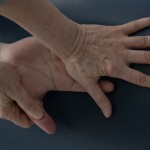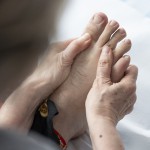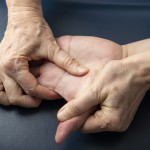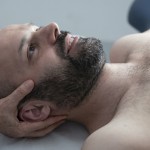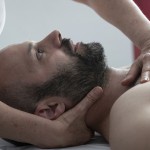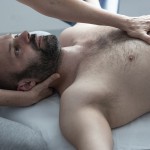BASIC PRINCIPLES
Although the method cannot foresee an application manual due to its individualized nature, there are nevertheless some guidelines on which the technique of each treatment is based:
Most of the muscles are organized in groups, called chains by Mézières.
The chains comprise the phylogenetically oldest muscles; each chain behaves like a single large elastic, often too short, too stiff, and almost always contracted, even when we sleep.
The first chain that Mézières has defined is the posterior one, the main one, the axis to which the others are connected: it includes the long and powerful dorsal muscles, which are inserted on the nape, along the entire column up to the sacrum; the chain extends with the buttocks, the posterior muscles of the thigh and legs, those of the sole of the foot and the front of the leg, up to below the knee, like a sock that is always too short, whose postero-superior edge goes up to nape. Mézières then defined the two chains of the upper limbs which include the flexor and pronator muscles (which keep the elbows and fingers flexed and the upper limbs in pronation even when we are relaxed). Finally, there are the two anterior chains: the one in the neck, which pulls our head forward and into a “bottle waiting” position, and the anterior-internal one which includes the diaphragm and the powerful ileo-psoas muscle, which goes from lumbar region to the femur.
The chains are all interdependent: every action of local lengthening causes a compensation, or a shortening in one or more points, therefore a segmental work is useless, if not counterproductive. It is therefore necessary to prevent such compensations so as to lengthen the entire chain and not the single muscle.
The manual technique consists of maneuvers with the main purpose of loosening muscle hypertonia, especially in the chain muscles, to harmonize agonists and antagonists in search of the ideal and perfectly balanced morphology.
Often the pathology manifested in the patient is due to a compensatory mechanism triggered by an upstream imbalance, the therapist’s task is to identify it, tracing this mechanism backwards, and act on it to solve the downstream problem.
The treatments are all the more effective the more therapists act simultaneously, so as to limit compensations to a minimum and maximize stretching by pulling from several directions at the same time.
HOW IT IS BORN
Françoise Mézières (1909 – 1991) was a French therapist. He developed the concept of “muscle chain” and created the “Mézières Method”.
Born in Hanoi, her father, in fact, was part of the French embassy, lived in Indochina until the age of 6 and then moved to France. Expelled from her family at the age of 16 by an authoritarian father, she earned a living with small jobs and later began studying kinesiotherapy. He studied in Paris at the École Française d’Orthopédie et de Massage, learning the techniques of the time, in particular “corrective gymnastics”, based exclusively on muscle strengthening. She graduated the day before the evacuation of Paris due to the advance of the German troops, after the war she was called to teach in this same school.
In 1947, just after the publication of a pamphlet, a kind of compendium of medical gymnastics of the time, Françoise Mézières makes what she calls her “capital discovery”, which leads her to question the techniques of the time, to develop new concepts and to create the method that will then bear his name.
In 1949 he published Revolution of Orthopedic Gymnastics, coldly received by the medical world. He then left the professorship and opened his own independent studio to continue his studies and research. In 1967 he presented his method to the Homeopathic Center of France, but it was the publication in 1976 of Healing with antigymnastics by Thérèse Bertherat, in which some pages dedicated to his method appeared, to procure her notoriety, even abroad, until she received the decoration of the Legion of Honor.
Laura Bertelè, born on 9/7/1952 in Ballabio (LC), graduated in Medicine and Surgery on 11/7/1976 at the State University of Milan and subsequently obtained the specialization, also in Milan, in Physical Therapy and Rehabilitation movement with Professor Cecilia Morosini discussing the thesis: “Mézières method: new hypothesis of postural re-education”.
At the age of twenty-six he became a permanent assistant in Orthopedics and Traumatology at the Cernusco sul Naviglio hospital, and then decided three years later, the first and only doctor, to participate in the training course on the Mézières method held by Françoise Mézières in Gers, France .
Returning to Italy, she resigned from the hospital and began freelance work in close collaboration with Mézières from which she returned numerous times to assimilate and refine the technique more and more.
In 1984 she was chosen by Françoise Mézières herself as a teacher in her training school together with Françoise Tisserand, a French therapist.
In the same years it follows:
training in psychokinetics with Professor Jean Le Boulch in France and Italy
the training of the Tomatis method, becoming in turn a teacher and manager of the Italian network before leaving it due to strong differences on technical aspects of the equipment and deliberately ignored side effects
Chinese massage, connective tissue massage, deep lymphatic drainage courses
gentle gymnastic courses (Feldenkrais, eutony, antigynastic, Rolfing) and contemporary dance.
Session after session, what Wilhelm Reich and Alexander Lowen, founders of Bioenergetics argue, appears more and more evident and real: muscles are real armor in which we accumulate our emotions, which, if properly treated, yield like dams, freeing the emotional load that flows sometimes like a slow river, sometimes like a tumultuous torrent. During the work on the body, the Bertelist can feel, through the hands, waves that the individual can perceive, conscientize, verbalize, or express with tears or vegetative reactions.
To deepen the emotional side, Laura Bertelè for years participated in psycho-body psychotherapy sessions with various psychotherapists of different orientations, until she enrolled in the Lombardy Order of Psychologists on 18/06/1993.
WHAT IS IT’
Each session is a new path, a path, a ford in which the operator supports, supports and accompanies the person.
From Laura’s experience, a method was born that integrates the body technique inherited from Mézières, with a broader philosophy, which considers the person as a whole of body-mind-emotions, inserted in a socio-family environment with which interacts continuously.
In order to aim at the health of the patient as a whole, Dr. Laura Bertelè has collaborated with various specialists with a common commitment: the search for the multiple causes that may be at the basis of a complex problem and the investigation of the possible interrelations between different organs and systems, too often studied individually in medicine.
The closest collaborators of this network, which is growing more and more, are:
Dr. Antonio Busato, a specialist in the chewing system (orthognathic dentist) who carried out a research with Dr. Bertelè on 120 children with scoliosis, with ultrasound checks on the chewing muscles. (https://vismara-busato.com/)
Dr. Mario Cigada from Milan, ophthalmologist, psychotherapist specializing in the re-education of oculomotricity who has studied the relationship between oculomotricity and posture. It has been shown that phorias above all cause compensation in the cervical and spine muscles. (http://www.mariocigada.com/)
Psycho-neuro-endocrine-immunological network specialists (Dr. Ivana Basile and Dr. Maria Sarah Trabucchi). Specific tests can detect the relationship between the immune system, chronic viral infections and muscle stiffness. Dr. Maria Sarah Trabucchi, immunologist, is also an expert in acupuncture, pain therapy, homeopathy, Dr. Ivana Basile, homotoxicologist, expert in natural therapies and in accompanying communication especially for people with severe motor limitations and complex problems in children with severe neuromotor injuries. Link with Nassigh association. (https://associazionecxc.org/)
Prof Paolo Bellavite specialist in clinical hematology specializing in health statistics and clinical epidemiology, former professor of general pathology at the University of Verona and professor at the Ngozi University (Burundi). (http://www.paolobellavite.it/)
This declaration of intent represents the cornerstone of this approach both in the rehabilitation field and in the prevention and well-being of the person. The method, in fact, does not consist in the simple uncritical application of a rigid protocol, but requires the practitioner who practices it to reorient itself towards the individuality and uniqueness of the patient.
HEALTH WITH THE BERTELE ‘METHOD
“Be in your hands, be your hands. (F. Mézières)”
The technique is performed manually with suitable maneuvers on the muscles whose main purpose is to loosen muscle tension, especially that of the chains to allow the antagonists (pectoral, abdominal, quadriceps) to tone up, harmonizing the entire system with constant reference to morphology ideal. The subject is lying on a special bed (Bertelè bed) or on a carpet. It always starts with the subject supine and gradually takes him to the postures of greatest elongation in a seated position or with limbs lower than 90 °. The only aids used are pads of various sizes and densities and soft bands.
In the basic posture (put in axis) the subject is treated in the supine position: the primary purpose is to stretch, through stretching postures and massages, the muscle chains, so that they no longer brake the joints, and the other muscles can regain function and recover the lost tone. In this way all those “knots” that are harmful to joints, tendons, ligaments, discs and menisci are dissolved.
The Bertelist’s task is to hunt for compensations in order to discover the true origin of the problem and to trace, by letting himself be guided by the body, the chain of adjustments that the patient has unconsciously implemented in order to be able to bear the original and originating pains. Throughout the treatment, the operator must correct the compensations that the body gradually finds in order to escape elongation: the body, in fact, cannot tolerate constrictions (whether they are orthodontic appliances, orthotics, corsets, stretches) and always tries to escape by writhing.
THE METHOD IS FIRST A MEANS BY WHICH THE PATIENT CAN LEARN TO LISTEN TO THEIR BODY.
We repeat that its application is strictly individual. Since the muscles, like any elastic material, cannot self-stretch, an external force applied to the body is required so that the short and retracted muscles are stretched and made more elastic, with manual massages and ad hoc postures. The one-hour sessions are carried out on a weekly basis at least for the first 4-5 sessions, then in relation to the result obtained they can be diluted at a fortnightly and then monthly. The monthly maintenance can continue over the years. In very acute situations, by prescription, 2-3 sessions a week can be performed for a few weeks. For very young children, the bertelist teaches parents a stretch to be performed daily for about 10 minutes and then supervises them with sessions every ten to fifteen days.
In more complex situations, two or more bertelists participate in the sessions to lengthen the chains and correct the compensations.
When it is necessary to obtain a more radical and lasting change in posture, weeks of sessions are to be provided. Many bertelists must participate in this intensive cycle in order to perform three or four sessions at the same time on the subjects concerned.
OBJECTIVE EXAMINATION
The physical examination is the essential moment of the method. The protocol concerns an absolutely individual observation methodology of the body that allows to “photograph” the situation of that body at that moment and to compare it with an ideal morphology, perfectly symmetrical and harmonious.
For an expert eye, the exam takes a few minutes.
The patient is observed in an upright position, undressed, with feet together, first from behind, then from the front and finally in profile, noting on a special card all the details that do not conform to the ideal morphology of that body.
In this way, postural problems can be identified in a timely manner that may require rebalancing sessions or, in more serious cases, the need for specialist visits.
It begins by observing the position and support of the feet, the shape of the lower limbs, in particular the rotation of the knees, the morphology of the trunk, the axis of the spine, the alignment of the shoulder blades and shoulders, which must not be neither go up nor rotated, the arms which must not be rigid or flexed, and the position of the head, which must not be placed before but in axis.
The bertelist, both medical, health operator, and muscle harmonizer must fill in a special form to document the results of the physical examination with photographic images in front of a squared table or behind a squared grid and on a platform with a camera in a fixed position. , person standing, back, front and the two side profiles.
The bertelist must measure the height before and after the session with an altimeter to document changes in height, monitoring it over time.
These assessments are performed before and after each session in terms of physical examination and height detected, with photographic images after each session or after a certain number of sessions (with frequency every 5, 10, 15, 20 sessions, or every 3 – 6 months ).




